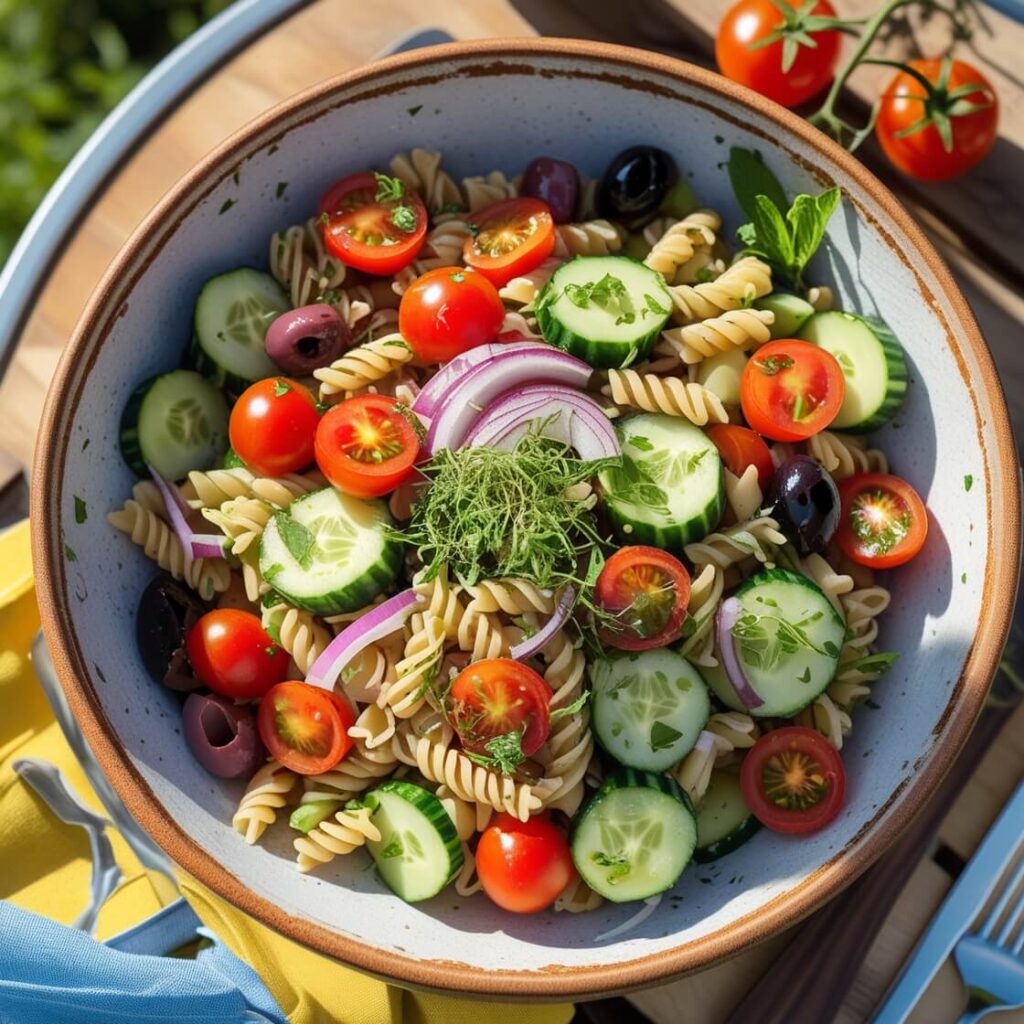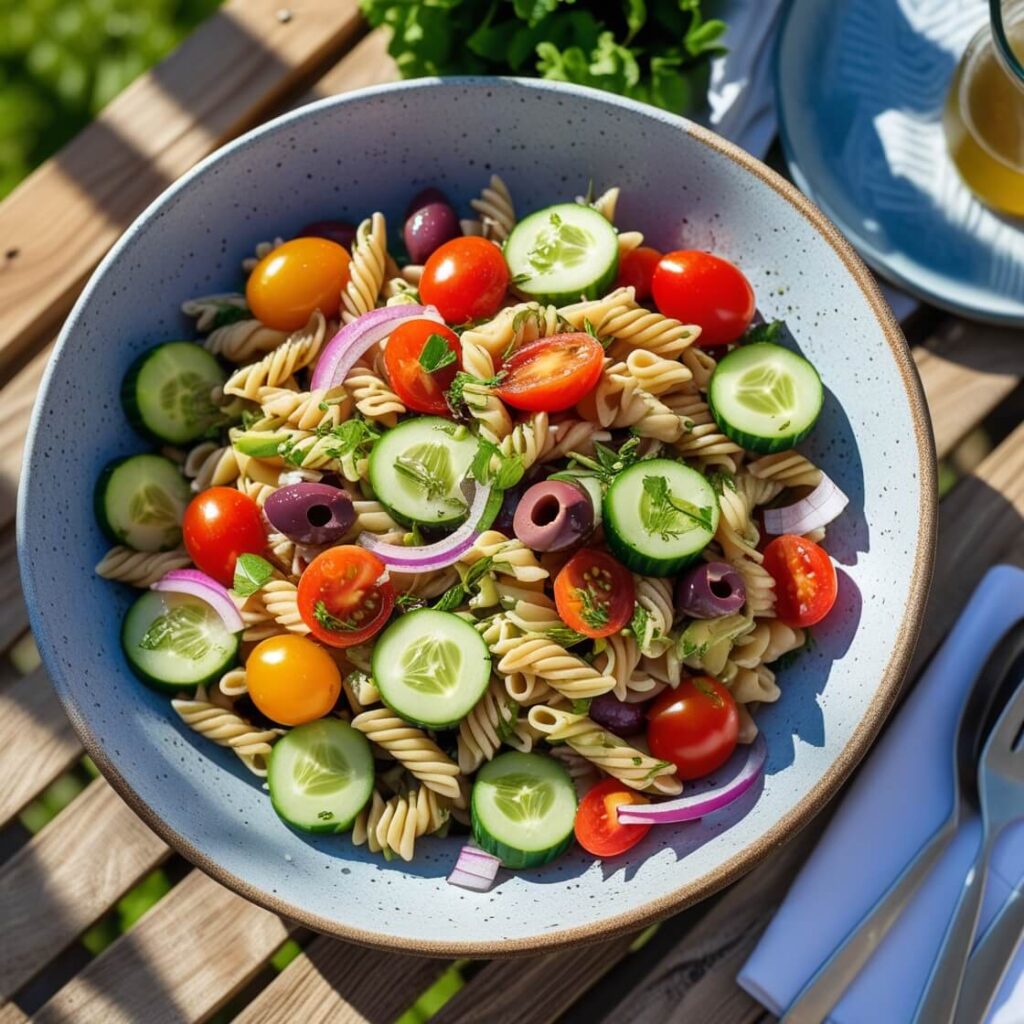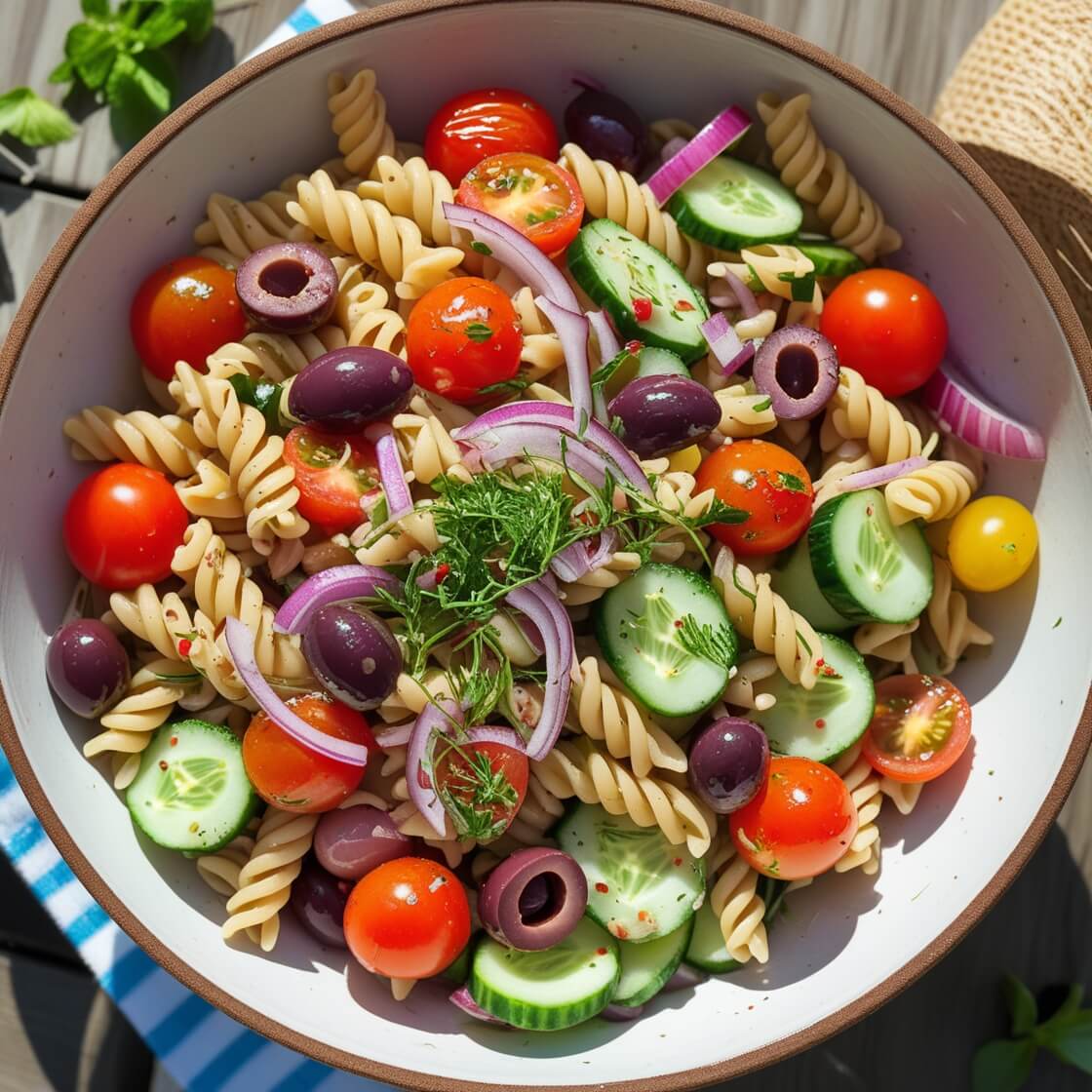Healthy summer pasta salad transforms ordinary ingredients into a vibrant culinary masterpiece. I’ve found that combining 5 cups of cooked pasta with 2 cups of corn, fresh avocado, and colorful peppers creates a nutritious dish that’s often the first to disappear at gatherings.
When made with whole grain pasta and fresh vegetables, this crowd-pleaser becomes significantly more nutritious than traditional pasta salads. Additionally, you can prepare most versions in just 20 minutes, making it perfect for busy weeknights or impromptu get-togethers. For instance, our Mediterranean variation uses short pasta shapes like fusilli or farfalle to better catch the light dressing—containing just 1/3 cup of mayonnaise instead of the heavier amounts found in traditional recipes. What’s more, these salads can be customized with various proteins and vegetables to suit your preferences, and they’ll last in your refrigerator for up to 4 days.
The Chef’s Philosophy Behind a Healthy Summer Pasta Salad
As a professional chef, I approach summer cooking differently than other seasons. Summer pasta salads aren’t merely cold versions of hot pasta dishes—they represent an entirely unique culinary philosophy that embraces the season’s bounty and dining style.

Healthy Summer Pasta Salad – Fresh, light, and vibrant!
Why summer salads are different
Summer presents a distinctive culinary landscape with abundant fresh produce and different eating patterns. During warmer months, I find that appetites naturally gravitate toward lighter, refreshing dishes rather than heavy, hot meals. The seasonal shift demands recipes that celebrate freshness while providing satisfying nourishment.
Summer pasta salads differ fundamentally from their winter counterparts in three key ways:
First, they prominently feature raw or barely-cooked ingredients, preserving the vibrant colors and crisp textures unique to summer produce. Second, their flavor profiles emphasize brightness—think acidic notes from vinegars and citrus that wake up the palate on hot days. Finally, summer salads prioritize make-ahead convenience, allowing flavors to develop while keeping cooking heat minimal.
Moreover, summer pasta salads serve multiple functions in seasonal entertaining. They work beautifully as standalone meals, substantial side dishes, or potluck contributions that won’t wilt under the sun. This versatility makes them essential in any chef’s warm-weather repertoire.
Balancing flavor, texture, and nutrition
The art of creating a truly exceptional healthy summer pasta salad lies in achieving perfect balance across multiple dimensions. This balance isn’t merely about flavor—though that’s certainly important—but about creating a harmonious dish that satisfies completely.
Flavor balance requires careful attention to five fundamental tastes: salty, sweet, sour, bitter, and umami. I typically incorporate something briny (olives or capers), something sweet (perhaps cherry tomatoes or corn), acidic elements (lemon juice or vinegar), bitter components (arugula or radicchio), and umami-rich ingredients (aged cheese or sun-dried tomatoes).
Textural contrast proves equally essential. The ideal pasta salad juxtaposes:
- Chewy elements (properly cooked pasta)
- Crunchy components (fresh vegetables, nuts)
- Creamy ingredients (avocado, fresh mozzarella)
- Juicy additions (ripe tomatoes, stone fruits)
From a nutritional standpoint, I emphasize balance through thoughtful ingredient selection. Whole grain pastas provide complex carbohydrates and fiber. Fresh vegetables deliver essential vitamins and phytonutrients. Healthy fats from olive oil, nuts, or avocado enhance satisfaction and nutrient absorption. Finally, strategic protein additions—beans, cheese, or seafood—transform a side dish into a complete meal.
Indeed, the chef’s philosophy behind a truly outstanding healthy summer pasta salad centers on honoring ingredients at their peak while creating a dish that delights all senses.
Essential Ingredients for a Flavorful Base
Creating the perfect healthy summer pasta salad starts with selecting the right foundational elements. The ingredients you choose as your base will determine both the nutritional profile and flavor impact of your finished dish.

This Healthy Summer Pasta Salad is perfect for picnics!
Choosing the right pasta shape
The pasta shape you select plays a crucial role in how well your salad holds dressing and accompaniments. Short, twisty pasta shapes are optimal for pasta salads because “all the curves catch the dressing”. Specifically, fusilli, rotini, and cavatappi create the perfect contours for holding onto sauce and capturing bits of everything mixed into the salad.
Consequently, these spiral-shaped pastas have increased surface area, allowing more dressing to stick. Other excellent options include farfalle (bowtie), which has “ridges and folds [that] help hold in the flavor”, or smaller shapes like orzo for a more grain-salad consistency.
Generally, I avoid using fresh pasta (except tortellini) as it’s “much more delicate than dried counterparts, meaning they can get soggy and break down”. Furthermore, cooking technique matters—take the pasta just a minute or two past al dente, then immediately run under cold water to stop cooking.
Fresh vegetables that shine in summer
Summer vegetables bring vibrant colors, varied textures, and peak seasonal flavor to your pasta salad. Cherry tomatoes are particularly valuable for their “juicy tang” and natural sweetness. Likewise, zucchini and yellow squash add brilliant color and subtle flavor.
Essentially, a good vegetable mix should provide contrast. Bell peppers (especially red ones, which are “the sweetest”) deliver crunch and visual appeal. Broccoli florets offer nutritional density and texture. Fresh corn kernels bring natural sweetness that balances tangy dressings.
For additional dimension, consider adding cucumber for refreshing crispness or red onion for a sharper flavor profile. These vegetables should be “diced into small pieces” to ensure “you get a little of everything in every bite”.
The role of herbs and cheese
Fresh herbs elevate a simple pasta salad to something special. Basil is “the ultimate summer herb” that adds intense seasonal flavor. Parsley contributes brightness, while dill brings a distinctive tang that pairs beautifully with summer vegetables.
Regarding cheese, it provides both richness and saltiness that balances the bright vegetables and herbs. Mini mozzarella balls (ciliegine) add “chewy texture”, while feta contributes “a creamy texture and a perfectly salty taste”. Freshly grated Parmesan works wonderfully too, almost melting into the dressing.
Primarily, these three components—properly selected pasta, peak-season vegetables, and complementary herbs and cheese—form the foundation upon which an extraordinary healthy summer pasta salad is built.
Crafting the Perfect Dressing
The dressing for a healthy summer pasta salad serves as the crucial binding element that ties every ingredient together. In my professional kitchen, I’ve discovered that the right dressing can elevate a simple pasta salad into something truly memorable.

Eat clean with this Healthy Summer Pasta Salad!
Oil-based vs. creamy dressings
Oil-based dressings shine in summer pasta salads, creating light, refreshing flavors that don’t overpower fresh vegetables. These vinaigrettes allow the natural flavors of summer produce to take center stage. Primarily consisting of olive oil, vinegar, and seasonings, they coat ingredients without weighing them down.
Alternatively, creamy dressings provide richness and body, making them ideal for pasta salads featuring crunchy vegetables or those served as a main dish. A simple creamy dressing might combine ¼ cup mayo, ¼ cup Greek yogurt, 2 tablespoons apple cider vinegar, and 2 tablespoons olive oil with seasonings.
Throughout my cooking career, I’ve noted that oil-based dressings typically work better in warmer weather, whereas creamy versions add satisfying richness to heartier pasta salads with more vegetables and crunch.
How to balance acidity and sweetness
The secret to a perfectly balanced dressing lies in proper proportions. Subsequently, the classic ratio stands at 3:1—three parts oil to one part acid—creating harmony without overwhelming tanginess. In fact, most professional chefs adhere to this formula as a starting point.
Obviously, tasting remains essential. If your dressing tastes too acidic, add a touch of honey, maple syrup, or agave to round out the flavor. Pomegranate molasses offers another option with its tangy richness. Fatty ingredients like tahini, mashed avocado, or a spoonful of mayo can also tame excessive acidity.
For a successful emulsion, incorporate oil slowly into your acid base, whisking continuously. This method ensures your dressing stays properly blended instead of separating.
Chef’s go-to vinaigrette recipe
My foolproof pasta salad vinaigrette starts with combining 2 teaspoons Dijon mustard (which helps emulsify), ½ cup red wine vinegar, 2 teaspoons dried oregano, 1 teaspoon kosher salt, and ½ teaspoon black pepper in a mason jar. Afterward, add 1 cup extra-virgin olive oil and shake vigorously until emulsified.
Notably, this recipe makes a generous amount—about 1½ cups—which might seem excessive. Nevertheless, pasta requires abundant dressing as it absorbs flavors while sitting. Reserve a small portion separately for refreshing the salad just before serving.
For variations, substitute balsamic vinegar for a sweeter profile or add finely grated garlic, fresh herbs, or a pinch of red pepper flakes for extra dimension. Regardless of your additions, ensure your dressing tastes slightly bolder than you think necessary, as flavors mellow once combined with pasta and vegetables.
Pro Tips for Assembling and Serving
Beyond selecting quality ingredients, mastering the technical aspects of healthy summer pasta salad assembly guarantees spectacular results every time.
How to avoid soggy pasta
Despite common practice, pasta salad requires special handling. Initially, cook your pasta 2-3 minutes beyond al dente until very soft but not mushy. This counterintuitive approach ensures the pasta firms up to perfect texture once cooled. As one chef explains, “pasta that’s cooked al dente and then served cold is a disgrace” because cold starch becomes firm through retrogradation. Altogether, slightly overcooked pasta creates the ideal foundation.

Easy, colorful, and full of flavor – Summer Pasta Salad!
When to dress the salad
The double-dressing technique elevates ordinary pasta salad to extraordinary. First, toss still-warm pasta with about half your dressing immediately after draining. Throughout cooling, this initial dressing absorbs into the pasta, flavoring it from within. Later, just before serving, add the remaining dressing for moisture and fresh flavor. This two-stage approach prevents the disappointment of dry pasta salad, as “the pasta soaks up the dressing as it sits.”
Make-ahead and storage advice
Properly stored pasta salad remains fresh for 3-5 days in an airtight container. Given these points, planning ahead actually improves flavor—”letting it rest in the fridge allows the flavors to marry together.” For optimal freshness, consider preparing components separately: store cooked pasta, vegetables, and dressing individually, then combine shortly before serving.
Serving temperature and presentation
Unlike most assumptions, refrigerator-cold pasta salad is suboptimal. In contrast, room temperature serving allows flavors to bloom and textures to soften perfectly. Simply remove your pasta salad from refrigeration 20-30 minutes before serving. Meanwhile, give it a final toss to redistribute dressing that may have settled. Although food safety remains crucial—never leave pasta salad at room temperature beyond two hours.
For presentation, serve in a wide, shallow bowl that showcases vibrant ingredients and garnish with additional fresh herbs just before serving for both visual appeal and flavor enhancement.
Conclusion
Summer pasta salads undoubtedly represent more than just a convenient meal option—they’re a celebration of seasonal abundance and culinary creativity. Throughout this guide, I’ve shared my professional insights on transforming simple ingredients into exceptional dishes that balance nutrition, flavor, and visual appeal.
First and foremost, remember that your pasta selection matters significantly. Those twisty, ridged shapes like fusilli and cavatappi will capture dressing in their curves, ensuring flavor in every bite. Equally important is cooking technique—slightly past al dente creates the perfect texture once chilled.
Additionally, fresh summer vegetables provide the nutritional backbone of these dishes. Cherry tomatoes, colorful peppers, and corn kernels not only add vibrant colors but also deliver complementary textures and essential nutrients. Fresh herbs like basil and dill, meanwhile, elevate these ingredients with aromatic complexity.
The dressing, however, truly binds everything together. Whether you choose a light vinaigrette or creamy option, balancing acidity with just enough sweetness creates harmony. My two-stage dressing approach—adding half while pasta is warm and the remainder before serving—ensures deeply flavored results every time.
Last but certainly not least, proper assembly and serving techniques transform good pasta salad into great pasta salad. Allowing your creation to reach room temperature before serving unlocks maximum flavor, while keeping components separate until needed extends freshness for make-ahead options.
Above all, healthy summer pasta salads showcase versatility. They adapt beautifully to whatever produce looks best at your market, accommodate dietary preferences with simple substitutions, and transition effortlessly from casual lunches to elegant dinner parties. With these fundamentals mastered, you’ll find endless possibilities for creating nutritious, delicious pasta salads all summer long.
About HealthyBlog365
Welcome to HealthyBlog365, your go-to destination for all things food and drink. We believe that every meal is not just a way to nourish your body but also a meaningful connection with yourself and your loved ones.
HealthyBlog365 was created with a mission to inspire healthy living through nutritious meals and refreshing beverages. Here, you’ll discover a treasure trove of creative recipes, kitchen tips, and healthy eating trends tailored to fit modern lifestyles.
 What can you find on HealthyBlog365?
What can you find on HealthyBlog365?
- Delicious and easy-to-make recipes: From simple meals for busy mornings to wholesome dinners for family gatherings, we’ve got you covered for every occasion.
- Nutritious drinks: Explore recipes for juices, smoothies, detox teas, and drinks that cleanse your body, boost your mood, and energize your day.
- Guides on eating habits: Get detailed insights into popular diets like keto, low-carb, and vegetarian-friendly meal plans.
- Kitchen hacks: Discover smart tips to save time, preserve food, and cook more efficiently.
We are committed to providing high-quality content, staying up-to-date with the latest trends, and maintaining a balance between nutrition and flavor.
 Connect with HealthyBlog365 on Social Media
Connect with HealthyBlog365 on Social Media
Join the HealthyBlog365 community on social media platforms to stay updated with our latest posts, watch exciting tutorials, and share your food stories with us:
Facebook: Follow us here to stay updated with our latest posts and join our community.
Instagram: Check us out here for inspiring visuals and ideas.
Pinterest: Pin with us here to save creative ideas you’ll love.
YouTube: Subscribe here for detailed tutorials and exciting videos.
 Thank You for Supporting HealthyBlog365!
Thank You for Supporting HealthyBlog365!
We aim to build a connected community where everyone can share and learn from each other. If you have any questions or suggestions, don’t hesitate to reach out to us via social media or our website.
We hope you have a wonderful time on HealthyBlog365 and find new inspiration for your healthy culinary journey!

